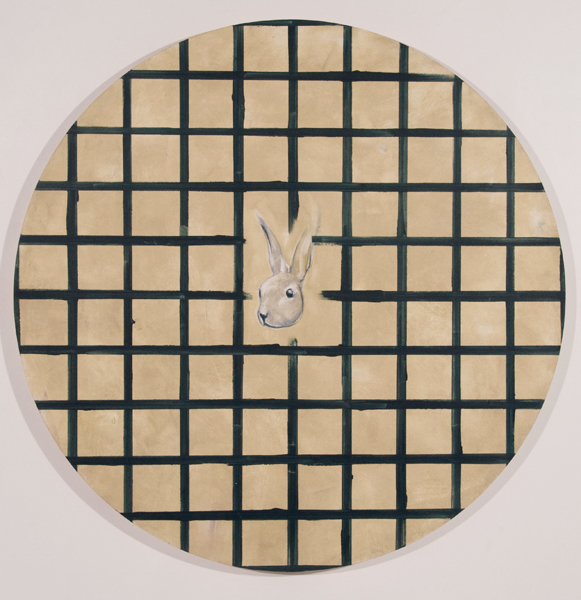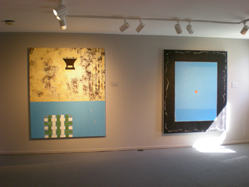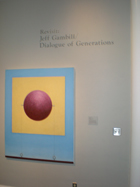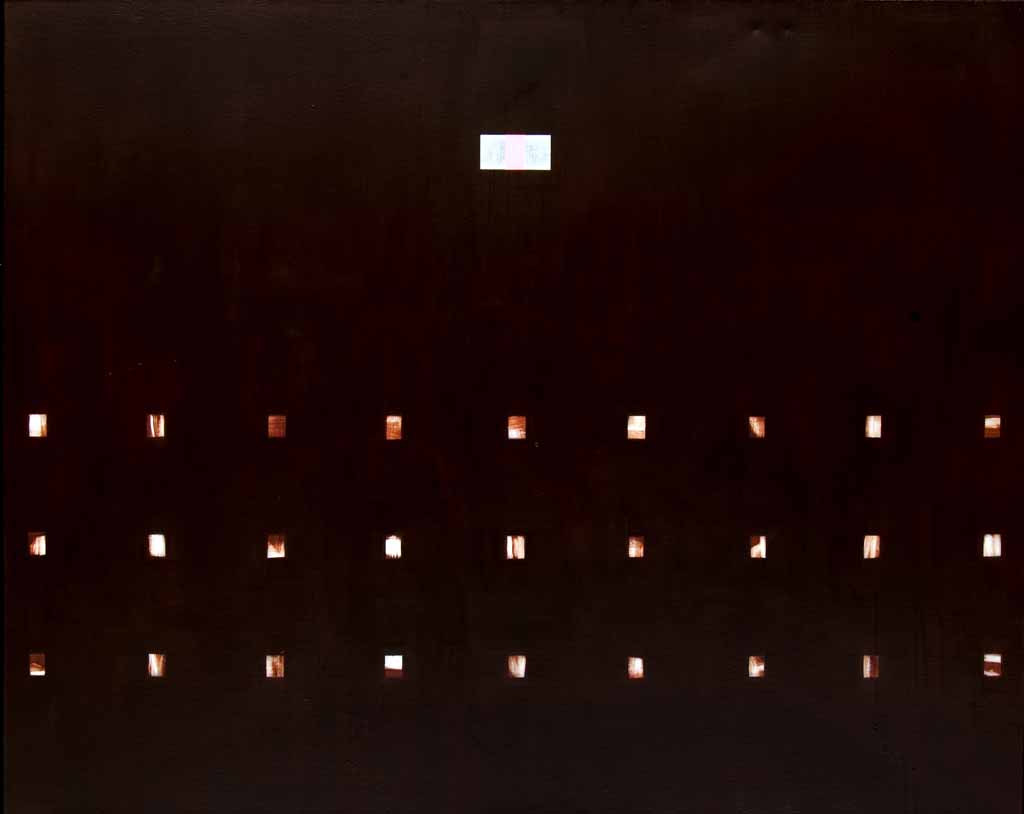 Slap 2011
Slap 2011 home
Jeff Gambill Studio
Statement for the exhibition Slap
Sam Lee Gallery, Los Angeles, CA, 2012
 Slap 2011
Slap 2011
What is it with memories? Why do we remember some things and not others? I have often worked from my memories over the years, challenged by finding ways to bring these elusive and fading thoughts to canvas. In the works for this exhibition, the memories themselves tend to be of rather mundane subjects from childhood. It is interesting to me that they have remained with me for so long. Why have these seemingly so ordinary of moments stayed with me for so many years, while many memories that, on the surface, would seem much more important, have long ago slipped away?
So, okay, the memories have stuck around, so what do I do with them, so how do I translate them into something visually interesting and meaningful? In the studio, I set out to find ways to reinterpret what it is I am remembering and let it live its own life. As an artist, I think it is important to let go of what something means to you and find a shared meaning. You might want to strip down an idea, or you might need to add to it, or select just a small portion, whatever it takes to allow the idea to have meaning for others. I believe it is at this point that an artist makes a shift away from self-absorption and makes work that connects with others successfully. Ultimately, what these subjects might originally have meant to me is no longer important. Instead, what they become about in the viewer’s eyes, whatever that interpretation might be, is what gives them their significance.
So, here, an encounter with a potato farmer is interpreted with potato prints, and the experience of seeing my first snowfall and making my first snowman is described in a way suggestive of childhood scratch art. Running away from home and hiding in a nearby forest is shown as a dense cluster of branching shapes against a twilight sky. (My misadventure came to a quick end as darkness fell.) An old block and tackle abandoned in the woods becomes a surrealist portrait. I was once punished with a sharp slap on my hand when I decided to sprinkle a rabbit in its hutch while watering flowers in a garden. A misdirected dart finding a perfect trajectory… to impale itself in my foot. My grandfather’s cigar and walking sticks emerge from darkness, the sticks “whittled” from the surrounding paint. And, the goofy eye of a beloved stuffed dog stares at me through the rain, silently meeting its demise, soaked and abandoned, outside in a downpour.
As I said, little things, mostly banal moments, but they have somehow stuck with me. They would have little meaning to others. But, with a little prodding and a fresh outlook, some fresh paint, they become something new.
And, thank you to the artist Sheldon Figoten for allowing me to paint in circles.
Statement for the exhibition Barely There
Sam Lee Gallery, Los Angeles, CA, 2009
 Fuji Blur 2008
Fuji Blur 2008
This body of work was inspired by a visit to Japan, a place where I found a wealth of visual surprises to fuel my long-time interest in transitory, indefinable imagery. It seemed as if around every corner, in every shop window, shrine or garden, subway station… everywhere… there was to be found an unexpected visual experience. There is, of course, the collision of traditional and pop cultures that produces a seemingly infinite fallout. There is the gracefulness in which ancient things seem to exist so easily in the contemporary world, and the way nature is intertwined with the man-made. The paintings in this series found their beginnings in Japan’s visual richness… a reflection in a pond or stepping-stones in the shadows of a garden, in the patterns of fabrics, the neon nightlife of Tokyo’s streets, or the elegant presentation of a formal Kaiseki dinner. To see Japan’s cherry blossoms in full bloom, floating like clouds below the clouds, is a truly overwhelming experience. Yet, these references are really just the starting point and it is how things develop beyond the initial inspiration that determines what the painting will become.
While I believe I have an affinity for Asian art, I will readily admit an almost complete ignorance of the subject. My experience with Asian art is of the most informal nature, simply that of an artist looking at art. However, I believe there has always been a hint of its influence in my work. In this series, I have considered Japanese imagery using my western painter’s vocabulary. I feel I have produced paintings that are elusive, meditative and restrained, while at the same time remaining quirky and spontaneous. Much of what I work with is just beyond my grasp. It is from this sense of disconnection, of being barely there, that this series gets its title. Memories that seem so vivid become fleeting the moment I try to put them to canvas. Images are stripped of their literalness so they can become free to evolve. In other words, when a painting is not about the cherry blossoms that inspired it, then it becomes successful.
Statement for the exhibition Revisit: Jeff Gambill/Dialogue of Generations
Carnegie Art Museum, Oxnard, CA, 2007
 Exhibition view
Exhibition view  Dialogue of Generations
Dialogue of Generations
Dialogue of Generations Revisited
When looking at Dialogue of Generations I see a painting which shows the early development of elements that have continued throughout my career. Dialogue certainly has the surrealist influences of Max Ernst and Rene Magritte, two artists who have inspired my work. This is especially true of Ernst, whose experimentation with painting techniques led to works that merged representational and abstract imagery, which has been a continuing interest of mine over the years. Dialogue also displays many of the abstract elements that occur throughout my work. Square, rectangle, circle, line… these are basic to an abstract painter’s vocabulary. But in this painting things become a little uneasy when a surrealist influence is added to the mix. The circle becomes a floating spherical “balloon” and line literally becomes tie lines holding the balloon. The balloon floats in front of a simple square which is improbably suspended in air. And although the square reads as flat and two dimensional, as is often found in the language of abstract painting, the painting’s overall rectangle is a brilliant blue sky. A simple ground plane, an element often appearing in my work, anchors the entire image.
It is curious for me to look at Dialogue of Generations once again in the context of this exhibition. Like any artist, my work has traveled in many directions in the 16 years since it was painted. The simultaneous exploration of abstraction and representation is found throughout my work and many components of my painterly vocabulary repeat consistently. The tie line and eyehook image re-appears in Blessed are the meek: for they shall inherit the earth. Lines and squares turn up in one of the Blacksmith paintings, and similar squares are seen in works such as the large Untitled 1997 from the China series, in Willow Glen, and in numerous other paintings. A version of the balloon with tie line appears again in one of the China paintings. Abstract elements floating in what can be read as either illusionistic space or as a flat plane is explored again in Berlin, where the imagery might be seen as city windows glowing in the night, but just as easily may be simple rectangles. The abstracted landscape seen in Dialogue occurs throughout my work. It is found in Blessed are the meek…, certainly in the China series, throughout the Willow Glen paintings, and in recent works such as La Mer (m.e.) and That Moon, Again. (And, by the way, the
At first glance Dialogue of Generations may seem impassive in temperament and classical in its composition when compared to most of my work, which tends to be more painterly, intuitive and involved with process. (Dialogue was a direct translation from a drawing, which was a method I used much more at the time. Now I may refer to notebook sketches for some basic ideas, but generally I let a painting take its own path.) But what Dialogue of Generations may lack in emotion it makes up in humor and oddness.
And the title? Well, I have been influenced by autobiographical and family subjects over the years and several series have focused on those themes, including the series Milledgeville of which Dialogue is a part. So Dialogue of Generations could be read as a reflection on knowledge and history that is passed through a family’s generations. In the context of this exhibition, surrounded by its “family” that came after, the title finds a new meaning. Or maybe it’s a surrealist title with its references, if any, so obscure or convoluted that its meaning may be impossible to decipher. I’m not saying.
Statement for the exhibition ...and out of the corner of my eye...
Sam Lee Gallery, Los Angeles, CA, 2007
 Berlin 2006
Berlin 2006
My paintings have always begun from personal experiences and my current work continues that approach. However, in my recent work the personal is kept much more at a distance; identifiable imagery and narrative is less emphasized. In these works the personal sources of my imagery are kept mostly to myself and only the barest hints, the most ambiguous suggestions of subject are to be found. So, while these paintings find their beginnings in the familiar inspirations I have used before- memories of places, people or moments from my life, they retain little of those original sources and concentrate instead on the abstract elements that evolve as I work in the studio. I have always been interested in depicting things that are difficult to capture, such as a fading memory or something seen in a reflection in a window. These things can be quite intangible, like something seen out of the corner of my eye. How do you translate these things into paint? In my paintings I have pursued this by seeking out the indefinite place between abstraction and representation, a place that I have found to be very natural and fertile for me.
It seems that as I have been emphasizing the abstract in my
work my paintings have become increasingly meditative. You might say the paintings are
frequently about “painter’s moments,” those moments in the studio when you are
thrilled simply by the physical characteristics of paint, like a border that
forms when two fields of color push against each other, or the contrast between
a solid surface and a wash next to it, or how a small line scratched from the
wet paint with my fingernail might make the surface come alive. In recent years I have made a very
conscious effort to work with varying painterly methods within a body of work,
often within a single painting. So
in my paintings you will see pouring, printing, drawing, glazing,
finger-painting, illusionistic modeling, and so on. While this approach may seemingly result
in works that are unrelated in appearance (in fact, I find amusement in the
knowledge that some will assume the paintings have been made by different
artists!), I believe that when a viewer looks carefully they will find solid
relationships between the paintings, as well as numerous characteristics that
have been consistent in my work throughout my
career.
Statement for the exhibition Willow Glen
Rosamund Felsen Gallery, Santa Monica, CA, 2002
 Willow Glen 2000
Willow Glen 2000
The general subject of this series of paintings is the neighborhood of
Willow Glen in San Jose, CA where I grew up and the paintings are
titled from names of streets from the area.
Some of the paintings reference memories of experiences: my father’s
sunbathing spot in our backyard, a rocked side-yard that provided
maximum rays and also where he kept our little hibachi; playing bumper
pool at my friend’s house; a beautiful little girl who had recently
moved in next-door, swimming in her pool; a brilliant full moon I
attempted (and failed) to paint one night in what was one of my first
oil paintings.
Other paintings are of more generalized subjects: shag carpeting,
schoolyard blacktops; playing marbles; headlights on a winding road;
the many orchards around the neighborhood (which have since fallen
victim to the Silicon Valley sprawl) where we spent hours running wild.
Throughout the series I was exploring issues of painting techniques,
surfaces and color. I was conscious of the shifts between techniques:
brushstroke, pouring, dripping, scrubbing, squirting, printing,
sponging, scraping, glazing, drawing, etc., etc., etc. I was also
looking for the variations in surface that would result from these
changing processes while searching for color palettes that would capture
the temperament of each work. Always I was looking to make paintings
that are formal yet intuitive and personal; contemplative works with
touches of humor and longing that express small moments, many now
fading from memory.